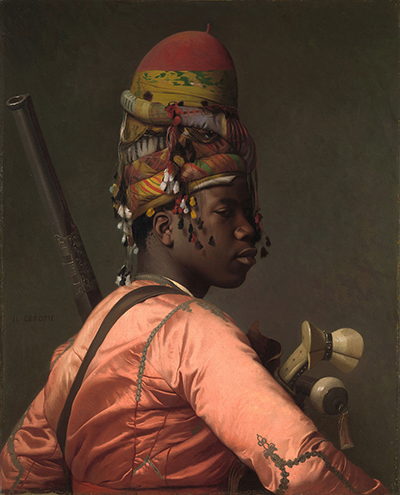This painting is arresting and simply wonderful. This may be down to Jean-Leon Gerome's superb skills with a paintbrush, but there must be some mention made of the subject: it is exceedingly rare to see a person of colour depicted as the predominant subject of a major work of art.
If they appear, generally, it is in minor and almost always subservient positions: slave, servant, or savage in some way. There is little excuse for this: diplomatic missions from Congo came to Lisbon in the 1480s, and Ethiopian missionaries were visiting Rome in about the same time. It is probably a hint of European squeamishness that saw the denial of the innate civilisation of African nations – if the people could be dismissed as little better than animals, then a narrative could be spun that slavery, while hard work to be sure, was actually beneficial, bringing teaching, religion and medical care to the otherwise spiritually, medically and politically impoverished.
Regardless of race relations at the time, Jean-Leon Gerome did choose to make this handsome black model the central subject of the painting, and did not, as some of his contemporaries might have been tempted to do – and which might have been seen as perfectly acceptable, given the title of the piece. Bashi-Bazouk referred to a rag-tag collection (because the word troop is surely inappropriate) of soldiers levied by the Ottoman Empire in order to swell their numbers in their advance across Asia and into Europe. These soldiers did not receive a salary, and were, instead, expected to survive on the proceeds of what they could seize, loot and otherwise acquire by force, stealth or crime.
This is hinted at in the image, given that the man is wearing a rather sumptuous pink satin jacket that was almost certainly not suitable for fighting in, teamed with a rather duller, but considerably more durable turban, adorned with tassels to emphasise the exoticism of the work – were the subject a real Bashi-Bazouk, then French society of the kind that Gerome would have been rubbing shoulders with would almost certainly never have seen anyone like that as regards the colour of his skin, the unique motley of his dress and the infamous brutality of his occupation.
The mere painting possibly caused something of a sensation amongst the genteel Parisiennes who would have viewed it in the safety of an art gallery or exhibition! The painting, currently on view at the Met in New York, is painted in oils on canvas, and is relatively small, measuring a mere 80.6 centimetres by 66 centimetres – offering a near life-size rendering of the subject.




